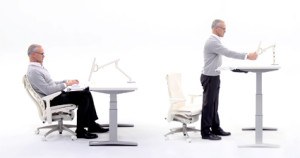The following tips are provided by the Ergonomics Program in CSU’s Office of Risk Management and Insurance.
Height-adjustable workstations are ideal in today’s office environment, where computer work is prevalent. Not only will a properly adjustable workstation/table properly “fit” a majority of the population (about 90 percent or more), when adjusted correctly, an adjustable workstation/table will allow for alternating between sitting and standing, which has great benefits.
Unfortunately, too much focus has been placed on standing more and sitting less, when the mixture of the two postures is most important. Although sitting for too long can have detrimental effects on the body, standing for too long has its own set of detriments such as pooling of blood in the feet, increased back pain, varicose veins, increased risk of atherosclerosis, etc. At the recent National Ergonomics Conference and Exposition, Dr. Joan Vernikos, former director of life sciences at NASA, simply said to stand up often. “Standing up often, at least 30 times a day, is a powerful antidote to sitting,” she said.
Ideally, when using a sit/stand height adjustable workstation, users should adjust and vary postures every 30-60 minutes or so and avoid long durations of either sitting or standing. Remember, the best posture is the next posture.
Even if you have an adjustable workstation, it does not mean you are free from all ergonomic risk. The correct height of the table, height and position of the keyboard and mouse, monitor(s), phone, etc., are crucial. Often a height-adjustable table is adjusted too high when sitting, forcing elevated shoulders and other awkward postures, which increases the risk for discomfort, fatigue and injury.
When considering an adjustable table or workstation, ensure the workstation will allow for proper hand working height for both sitting and standing. Work should be at or slightly below elbow height with your shoulders relaxed, your upper arms naturally by your side and elbows in 90- to 110-degree angles. When sitting and working on the computer, sit back completely in the chair, and adjust the keyboard to approximately 1-2” above your lap. Whether sitting or standing, your elbows should remain close to your body while working.
Height-adjustable platforms
Be aware of “platforms” and other equipment that sit on the desktop. Although these seem to be a growing trend and are easy to add and certainly allow for both sitting and standing to take place, if the proper adjustments cannot be made to allow for ideal hand working height for both sitting and standing, awkward postures are likely and risk for discomfort and fatigue increased.
For example, consider your shoe size. If you wear a size 9 shoe and were asked to wear a size 12 or larger and then run a marathon, it is likely you would wonder why you could not wear the size that fits your foot. The same is true for a workstation/table that is too high or low, it just does not fit. Adjusting a table or workstation to the correct height is much like getting a shoe that fits your foot.
An electric, pneumatic, counterbalance or electric-height adjustable table is the most ideal option for adjustability. Although initially expensive, these do not create ergonomic hazards since they are adjustable to fit almost everyone who uses the table for years down the line. (Crank tables are not recommended for use when the goal is to alternate between sitting and standing, because these require too many cranks to adjust and introduce a risk to the shoulder, arm, hand and wrist due to the number of cranks. Crank tables typically require approximately 10 cranks per 1 inch of adjustment. To adjust every hour as recommended, this will require approximately 100-160 cranks to adjust from sitting to standing, and vice versa, each time postures change. Over an eight-hour day, this is likely more than 400 cranks per day, which is far too many repetitions, considering the force to turn the crank.
Ergonomic evaluation
Ensure that the table is adjusted correctly. Too often, many of us wait until there is pain or discomfort before we make needed changes to our workstation setup. Rather than wait for discomfort, be proactive and schedule an ergonomic evaluation to quantify your risk for injury and ensure that the workstation is set up in the best way possible.
For more information, contact Frank Gonzales at 970-491-6745 or Frank.Gonzales@Colostate.edu.